numos
Hazard to Others
  
Posts: 269
Registered: 22-2-2014
Location: Pasadena
Member Is Offline
Mood: No Mood
|
|
Storing Chlorine as a liquid?
I've been wanting to do this for some time now, making Chlorine gas is easy, but safely storing it... I got away with Bromine by using an ampule, but
I'm a little skeptical about trying that with Chlorine.
What I want to do is store Chlorine as a liquid in a clear container, more for visual purposes than anything else. I don't want to use an ampule
because I'm afraid the liquid Chlorine will pressurize as it turns to gas and burst the ampule.
I know they have the acrylic boxes [see picture] that would probably contain the pressure, but is there an easier, and maybe a more space efficient
way to do this?
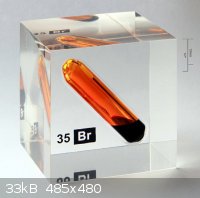
|
|
|
Marvin
National Hazard
   
Posts: 995
Registered: 13-10-2002
Member Is Offline
Mood: No Mood
|
|
Without the ampule the chlorine would eat it's way through the plastic, so you need something strong enough to contain the pressure anyway. The
element samples contain a tiny amount of material for chlorine which look bigger due to lensing effects of the tube. If this is for a collection you
would be far better buying a well made sample.
|
|
|
testimento
Hazard to Others
  
Posts: 351
Registered: 10-6-2013
Member Is Offline
Mood: No Mood
|
|
Thick walled glass ampoules and containers are supposed to keep well with pressures required to hold down chlorine, but they are very dangerous due to
shattering risk. Industry uses (afaik) PTFE and PVDF and monel lined containers for chlorine handling, and then, chlorine must be carefully dried.
|
|
|
subsecret
Hazard to Others
  
Posts: 424
Registered: 8-6-2013
Location: NW SC, USA
Member Is Offline
Mood: Human Sadness - Julian Casablancas & the Voidz
|
|
For most purposes, normal ampoules will not work. At room temperature, chlorine will produce almost 100 psi of pressure. Additionally, heating the
tube to seal it would vaporize the chlorine. You'd certainly need to seal it into some sort of plastic container...
To seal it into acrylic without heating, you could potentially buy two blocks of acrylic, and file out a slit just bigger than the ampoule. Then, take
some acrylic cement, (dichloromethane works for this purpose, IIRC) and glue the two halves together with the chlorine ampoule inside. Quickly clamp
the block in a vice to keep it from popping apart...
Plastics suppliers also carry acrylic cement, if I'm not mistaken.
Fear is what you get when caution wasn't enough.
|
|
|
AJKOER
Radically Dubious
    
Posts: 3026
Registered: 7-5-2011
Member Is Offline
Mood: No Mood
|
|
One should mention the existent of Chlorine hydrate, which may be of use here as either a storage device or for its direct use in chlorination. It
remains a solid in a open tube until 9.6 C, above which point it decomposes into Cl2 gas and Chlorine water with effervescence. It will remain as a
solid in a closed tube below 28.7 C (or 83.7 F), see http://books.google.com/books?id=h4_zgw9DZ1cC&pg=PA103&a... .
It can be prepared somewhat easily when gaseous chlorine (or liquid Cl2, see Patent 4,678,656 at http://www.google.com/patents/US4678656 ) is combined with water (or water containing ZnCl2,..) cooled in ice, or by mixing Cl2 gas and steam and
cooling (see Patent 3,908,001 at http://www.google.com/patents/US3908001 ). The Chlorine hydrate separates out as almost white crystals.
The cited formula for the hydrate is Cl2.yH2O where y is between 6.01 and 7.63 depending on its preparation path (see "VARIABLE COMPOSITION OF
CHLORINE HYDRATESSYNTHESIZED UNDER VARIOUS CONDITIONS", link: http://www.google.com/url?sa=t&rct=j&q=&esrc=s&a... ).
A good discussion of Chlorine hydrate can be found in "A review of the oldest known gas-hydrate - The chemistry of chlorine hydrate", link: http://www.google.com/url?sa=t&rct=j&q=&esrc=s&a...
Note, Chlorine hydrate will react with NH3 and ammonia salts to form N2, HCl and small amounts of the oily deadly explosive NCl3,with less forming
with ammonia than its acidic salts.
-------------------------------------------------------------------
A cool part of working with Chlorine hydrate is that upon melting:
Cl2. 7 63/100 H2O --Heat--> Cl2 + H2O + 6.63 H2O = HCl + HOCl + 6.63 H2O
implying that the by weight Hypochlorous acid strength may approach 30.5%. At this concentration, it is unstable readily forming HClO3 via
disproportionation. As such, I will try mixing the dry Chlorine hydrate and say, Na2CO3 (or NaOH) plus KCl, and upon warming, may be a convenient path
to chlorate production with KClO3 separating out on cooling.
[Edited on 24-2-2014 by AJKOER]
|
|
|
numos
Hazard to Others
  
Posts: 269
Registered: 22-2-2014
Location: Pasadena
Member Is Offline
Mood: No Mood
|
|
The acrylic idea is worth experimenting with for visuals. I'll post it if I get it to work.
This Chlorine hydrate fascinates me. Can't seem to find very much about it online even though is seems like a great way to store chlorine for a home
chemist; would something similar occur if hydrating the other halogens, Fluorine maybe?
|
|
|
Dr.Bob
International Hazard
    
Posts: 2658
Registered: 26-1-2011
Location: USA - NC
Member Is Offline
Mood: No Mood
|
|
Fluorine reacts with water to form HF and O2, so no fluorine hydrates for you.
|
|
|
AJKOER
Radically Dubious
    
Posts: 3026
Registered: 7-5-2011
Member Is Offline
Mood: No Mood
|
|
OK, Fluorine hydrate, assuming it can be prepared, is a big no (reputedly explosive forming, I suspect, corrosive and toxic Hydrogen fluoride gas on
detonation to make matter worse). Per one source (link: http://www.chemicalbook.com/ChemicalProductProperty_EN_CB122... ) to quote:
"Water vapor will react combustibly with Fluorine; an explosive reaction occurs between liquid Fluorine and ice, after an intermediate induction
period, [NASA SP-3037: 52(1967)]: If liquid air, which has stood for some time is treated with Fluorine, a precipitate is formed which is likely to
explode. Explosive material is thought to be Fluorine Hydrate, [Mellor 2:11(1946-1947)]."
---------------------------------------------------
Bromine hydrate appears to be difficult to isolate. Likely formula,Br2.10H2O (see http://pubs.rsc.org/en/content/articlelanding/1932/jr/jr9320... ).
---------------------------------------------------
No info found on a possible Iodine hydrate.
|
|
|
DrChemistRabbit
Harmless

Posts: 19
Registered: 17-12-2013
Location: China
Member Is Offline
Mood: No Mood
|
|
Quote: Originally posted by numos  | I've been wanting to do this for some time now, making Chlorine gas is easy, but safely storing it... I got away with Bromine by using an ampule, but
I'm a little skeptical about trying that with Chlorine.
What I want to do is store Chlorine as a liquid in a clear container, more for visual purposes than anything else. I don't want to use an ampule
because I'm afraid the liquid Chlorine will pressurize as it turns to gas and burst the ampule.
I know they have the acrylic boxes [see picture] that would probably contain the pressure, but is there an easier, and maybe a more space efficient
way to do this?
|
see this:
the liquild chlorine was sealed into a thick quartz ampoule,and the ampoule was enhanced by resin brick.
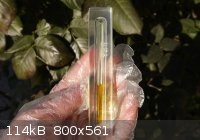
Chem is try.
|
|
|
phlogiston
International Hazard
    
Posts: 1375
Registered: 26-4-2008
Location: Neon Thorium Erbium Lanthanum Neodymium Sulphur
Member Is Offline
Mood: pyrophoric
|
|
DrChemistRabbit, beautiful sample, did you make that yourself?
-----
"If a rocket goes up, who cares where it comes down, that's not my concern said Wernher von Braun" - Tom Lehrer |
|
|
DBX Labs
Hazard to Self
 
Posts: 57
Registered: 24-12-2020
Member Is Offline
|
|
Currently making a quick video on this. I purchased some silicone molds but my first attempt at sealing a borosilicate ampoule of chlorine tested to
120F in acrylic resin worked out great.
On a side note, it is now permanently stuck within the graphite.
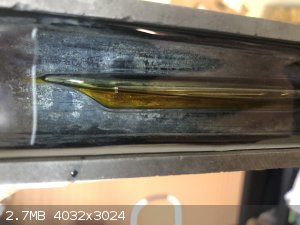
|
|
|
clearly_not_atara
International Hazard
    
Posts: 2692
Registered: 3-11-2013
Member Is Offline
Mood: Big
|
|
I guess this isn't meant to be opened ever 
You could probably ampoule ICl3, which decomposes to release chlorine. There's also VCl4, a liquid that decomposes to VCl3 and Cl2 at 148 C. Or SCl2
which decomposes to S2Cl2 and chlorine. It turns out that a lot of compounds release chlorine.
(The sulfur version even offers a decent storage density; about 1/3 of the mass is usable!)
[Edited on 04-20-1969 by clearly_not_atara]
|
|
|
DBX Labs
Hazard to Self
 
Posts: 57
Registered: 24-12-2020
Member Is Offline
|
|
Just finished my video on the Liquid Chlorine ampouling process.
https://youtu.be/udf-KSMd8yw
|
|
|
vano
National Hazard
   
Posts: 661
Registered: 22-3-2019
Location: Georgia
Member Is Offline
|
|
I watched your video. Does the ampoule not explode at room temperature? before you put it in the liquid resin.
|
|
|
DBX Labs
Hazard to Self
 
Posts: 57
Registered: 24-12-2020
Member Is Offline
|
|
Quote: Originally posted by vano  | | I watched your video. Does the ampoule not explode at room temperature? before you put it in the liquid resin. |
I use 100 mm long, 13 mm wide, and 1.5 mm walled borosilicate test tubes to form my ampoules which IF properly ampouled can hold about 15 atm on
average. The vapor pressure of chlorine at room temp is something like 6.5 which fits nicely in that margin. Prior to storing for any period of time I
heat the ampoules to 55C in water to ensure that they won’t ‘splode.
It’s definitely not safe to leave high pressure ampoules lying for months on end, that’s why I seal them in acrylic resin to make them fall-safe,
heat-safe, and collection-safe. Only downside is that you can’t ever easily crack them open, but who needs room temp liquid chlorine anyways.
[Edited on 3-4-2021 by DBX Labs]
[Edited on 3-4-2021 by DBX Labs]
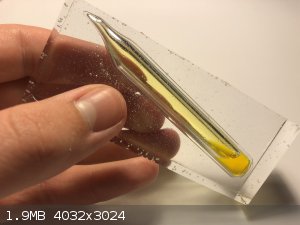
|
|
|
vano
National Hazard
   
Posts: 661
Registered: 22-3-2019
Location: Georgia
Member Is Offline
|
|
I understand. Thanks
|
|
|
metalresearcher
National Hazard
   
Posts: 731
Registered: 7-9-2010
Member Is Offline
Mood: Reactive
|
|
Good idea, but Cl2 can also be produced using KClO3 + HCl solution.
Two parts of CaCl2 + three parts of snow or crushed ice make -55C as well. No dry ice needed (which is mostly unavailable in shops).
https://en.wikipedia.org/wiki/Frigorific_mixture#Other_examp...
|
|
|
DBX Labs
Hazard to Self
 
Posts: 57
Registered: 24-12-2020
Member Is Offline
|
|
Yeah, a few commenters have referred to using mixes of CaCl2 and water to get to those temperatures required for the condensation of chlorine. I'm
sure that's what I would have had to resort to if my local grocery store didn't sell dry ice for less than 2$ a kilo.
As for the other route to producing chlorine, I've got an absolute ton of pool chemicals with 30 kilos of TCCA being just one of them. On a side note,
wouldn't the reaction of KClO3 with HCl also produce a substantial amount of ClO2 as well as free chlorine? It could be pretty dangerous letting that
build up in a glass flask on a sunny day 
|
|
|
woelen
Super Administrator
        
Posts: 7976
Registered: 20-8-2005
Location: Netherlands
Member Is Offline
Mood: interested
|
|
KClO3 + HCl is not at all useful for production of Cl2. If you mix these chemicals, you get an intense yellow liquid and a lot of ClO2 besides Cl2.
Bleach + HCl is useful for making Cl2, TCCA and Na-DCCA also are.
All these methods of making Cl2 produce a wet gas, contaminated with HCl as well. For certain reactions it must be purified, by first bubbling it
through water to remove the HCl and then passing it over CaCl2 or even better drying agents like P4O10 or H2SO4.
|
|
|
clearly_not_atara
International Hazard
    
Posts: 2692
Registered: 3-11-2013
Member Is Offline
Mood: Big
|
|
Tbh I'm not sure why you wouldn't just use HCl + MnO2; the product is drier (although not dry enough for everything), the reagents easier to handle,
and MnO2 can be regenerated.
[Edited on 04-20-1969 by clearly_not_atara]
|
|
|
DBX Labs
Hazard to Self
 
Posts: 57
Registered: 24-12-2020
Member Is Offline
|
|
13mL liquid chlorine ampoule per buyers request.
(Soon to be encased in resin)
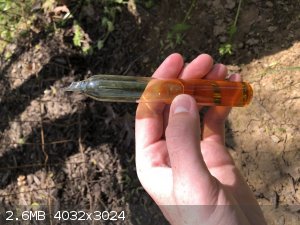
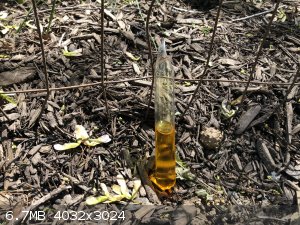
|
|
|